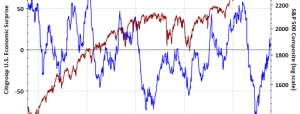President Trump’s comments and executive orders have roiled markets and investor expectations, but from the vantage of the Treasury market a relative calm prevails. This could change, of course, but for now key yields for government bonds are flat to slightly lower in recent days.The serene profile for Treasury yields is surprising, given the firehose of news updates on topics that, in theory, are relevant to market expectations, inflation, and economic growth. It’s only Wednesday, but Trump so far this week has launched a trade war only to dial it down, offering what may be a to plans to impose 25% tariffs on Canada and Mexico (a new still applies).One of the concerns is that tariffs will raise prices, thereby stoking inflation. Optimists note that any inflationary bump due to a tariffs would likely be a one-time affair. Perhaps, but stronger pricing pressure is problematic at a time when the Federal Reserve is still trying to complete the last mile of taming the pandemic-driven inflation surge.One theory that’s being discussed is that the Fed may take pre-emptive action if it expects that a global trade war will fuel a new run of inflation. But San Francisco Fed President Mary Daly earlier this week downplayed plans to tighten policy early on.The Fed does not “need to be pre-emptive at this point,” Daly The New York Times on Monday. “We have policy calibrated for this economy and the one we expect to have, and we’ve got time now to be actively watching to see what else is done.”The Treasury market appears to be on board with watch-and-wait idea. The 10-year yield eased yesterday (Feb. 5) to 4.51%, which is well below its recent peak of roughly 4.80% in January.(Click on image to enlarge)The policy-sensitive 2-year yield is also edging lower, dropping to 4.22%, comfortably below its previous ~4.40% peak.(Click on image to enlarge)Given the news flow of late, it’s more than a little surprising that yields have edged lower. But for now the market is looking through the headlines and effectively telling us that a disinflationary wind is still blowing. are leaning into that view: this market is pricing in an 83.5% probability that the central bank will leave interest rates unchanged again at the next policy meeting on Mar. 19.Perhaps the reasoning for the slide in Treasury yields of late is that a trade war also implies slower growth, or worse. In that case, one might argue that demand for safe-haven Treasuries has overwhelmed concerns about higher inflation.What the prevailing wisdom today, it’s easy to imagine that the outlook will change. President Trump has been known to change his mind in a heartbeat, on topics large and small. Predicting how US trade policy will evolve is challenging in the extreme at the moment.Some observers warn that chaos is a feature, not a bug, for Trump’s approach to trade. But for now, the Treasury market doesn’t appear overly concerned, at least in terms of inflation risk. Markets can be wrong, of course, and perhaps that’s true in this case. The relatively placid downshift in Treasury yields in recent days, however, implies that the crowd is less anxious about inflatino than one would expect given the headlines.To be fair, these are still early days in Trump 2.0 and it’s far too soon to make sweeping assumptions about the future. Until further notice, this is a day-by-day affair. A lot can happen in a 24-hour Trump news cycle. Yet what’s most striking so far is that, according to the Treasury market, not a lot has changed.Macro Briefing – Tuesday, Feb. 4Total Return Forecasts: Major Asset Classes – Tuesday, Feb. 4Macro Briefing – Monday, Feb. 3







